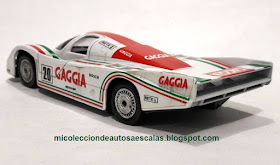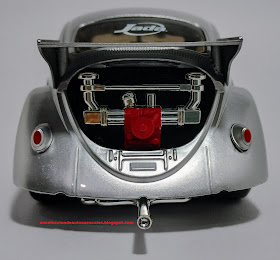- 1974 Dodge Charger
- Debut Series General Mills Promotion
- Produced 2004 - Present
- Designer Unknown
Este es un blog de fotografías para la colección personal de autos de diferentes escalas.
Thursday, March 28, 2019
Thursday, March 21, 2019
Thursday, March 14, 2019
2007 Dodge Viper GTS R Maisto 1:24
From Wikipedia: The Chrysler Viper GTS-R (also known as the Dodge Viper GTS-R when raced in North America) was a successful racing variant of the Dodge Viper developed in conjunction with Chrysler of North America, Oreca of France and Reynard Motorsport of the United Kingdom. Officially unveiled at the 1995 Pebble Beach Concours, it has won numerous championships and famous events in its history.
In the early 1990s, first-generation Dodge Viper RT/10s had been modified by racing teams for use in GT racing in North America and Europe without much success. Although its V10 engine was powerful, the car was not adapted to racing and teams lacked the funding to build a car that could compete with factory efforts. One key issue was the fact that the Viper was a roadster, therefore lacking the rigidity that a coupe bodystyle would have. However, following the sales success of the first generation Viper, Dodge began redesigning the car in 1995, upgrading the roadster while at the same time adding a new coupe, known as the Viper GTS.
Although the first generation Vipers had sold well, Dodge wished to showcase the potential capabilities of the new car, mostly in the realm of handling. At the same time, Dodge also hoped to increase sales in Europe where importation of the Viper had struggled. Dodge's parent, Chrysler, therefore approved the development of a racing program centering on the Viper GTS which was still in development at the time. This co-development would allow for elements of the racing car to be adapted to the road car, and vice versa, for each car's mutual improvement.
Chrysler believed that in order to adapt their car not only for North American but also European circuits, they would require outside assistance. An agreement was made with the French racing and engineering firm Oreca, who had many years of experience in sports car racing as well as assistance in the Mazda 787B's win in the 1991 24 Hours of Le Mans. Oreca would construct and maintain the racing cars in their shops, as well as run Chrysler's official factory teams in Europe. For North America, Chrysler would recruit the Canaska / Southwind Team to operate the factory effort.
Although Oreca would construct the cars, key elements would come from British engineering firm Reynard Motorsport. This would mainly consist of the construction of the car's basic chassis and other integral parts before they were shipped to Oreca for assembly. As for the Viper's engine, it was ideally suited for competition at the time due to limits of 8000 cc being just beyond the Viper's 7998.5 cc. Modifications were therefore light for the 356-T6 V10, with concentration on redesigned intakes for horsepower and reinforcements for endurance.
Thursday, March 7, 2019
1959 VW Volkswagen Pro Street Jada 1:24
Este es un VW Pro Street de la marca Jada, fué uno de los primeros autos agregados a mi colección y data del año 2007.
El Volkswagen "Tipo 1" es un popular automóvil del segmento C producido por el fabricante alemán Volkswagen entre 1938 y 2003, convirtiéndose en uno de los automóviles más populares del mundo. Fue comercializado por la marca con nombres como Sedan o Fusca, habiendo adoptado posteriormente el nombre popular Escarabajo debido a su forma (también Beetle y Käfer, las traducciones del nombre en inglés y alemán, a veces usadas en algunos mercados de habla hispana). También recibió otros nombres populares, como Vocho en México, entre otros nombres.
Es uno de los coches más clásicos de todos los tiempos, uno de los más elegidos por conductores de todo el mundo, debido a su economía de mantenimiento, aunque en el apartado del consumo de combustible otros coches del mismo segmento obtenían mejor resultado. El Volkswagen Tipo 1 es un coche reconocido a nivel mundial, representativo de la marca Volkswagen hasta el punto de que casi cualquier persona que lo vea sabe inmediatamente que es un Volkswagen por su inconfundible silueta.
Técnicamente, el Volkswagen Tipo 1 es un automóvil de bajo costo. Producido por el fabricante alemán Volkswagen entre los años 1938 y 1978 en Alemania, continuando su fabricación en México hasta 2003, siendo el automóvil con más tiempo de producción en la historia. Fue el primer automóvil de la marca y se construyeron y vendieron más de veintiún millones de unidades.
Inicialmente, en 1938, a este modelo de automóvil se lo denominó KdF-Wagen (Kraft durch Freude Wagen, en alemán, «'Fuerza a través de la alegría'»). Durante la Segunda Guerra Mundial (1939-1945) Alemania produjo muy pocos ejemplares con la auténtica carrocería de este modelo. En este periodo bélico, la producción se concentró sobre todo en adaptar su estructura a los modelos militares Kübelwagen y Schwimmwagen, pero una vez terminada la guerra, se retomó en 1945 la producción en cadena del Tipo 1 a gran escala y el modelo alcanzó desde entonces gran popularidad y prestigio mundialmente.




































